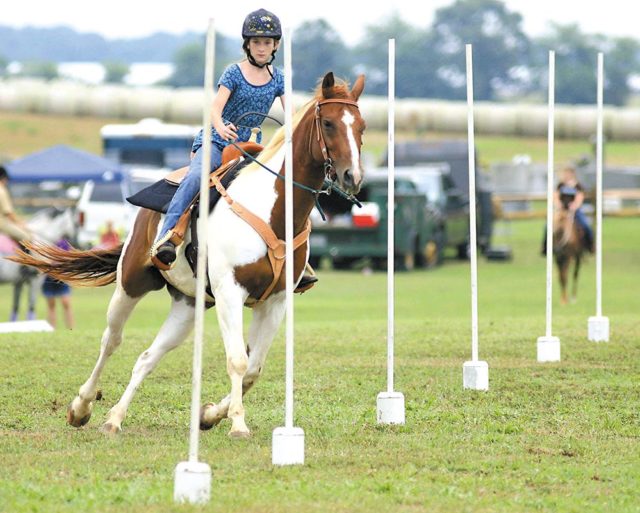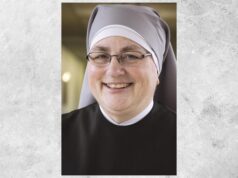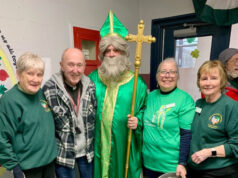
CORDOVA, Md. – This year’s St. Joseph’s Church Jousting Tournament will mark its 150th anniversary Aug. 1 while bidding farewell to a prominent aspect of the annual festival.
Riders and their horses have converged on the grounds of the church, known fondly as Old St. Joe’s, every August since 1868 to show their prowess as the riders, using lances, try to snag small rings hanging from lines across an 80-yard course. It is the second-oldest continuing tournament in Maryland; one in southern Maryland “has us by two years,” said Mike Boyle, one of the organizers.
Throughout its history, St. Joseph’s tournament was part of a day-long community affair. In earlier days, meals were held at midday and evening, and a dance at night. Over the years the evening meal and dance were dropped but a horse show was added.

This is the last year for the midday country dinner, Boyle said. He indicated it might have been dropped from this year’s tournament program except for its historical aspect.
“For the 150th anniversary, we wanted to maintain a tradition. Going forward we are not sure what will happen,” Boyle said. “This will be the last dinner as such, a big meal. We’re hoping to continue the horse show. The tournament will continue in some form.”
He cited demographics (“unfortunately, we do not have a lot of youth”) and societal changes as reasons for cutting back.
The dinner, for example, features country ham, barbecued chicken, potato salad, green beans, pickled beets, sliced tomatoes, applesauce, pickles and Maryland beaten biscuits and rolls.
“People don’t eat big dinners so much,” Boyle said. It also is “very labor intensive and takes a lot of people.”
For the Boyles and other families whose ties to Old St. Joe’s go back three, four and five generations, the change is hard. Boyle’s two brothers also are involved in the tournament: Gene is chairman and Jimmy and his wife produce the program books and help with the dinner.
Their ties in the area go back to their grandfather, who came from New Jersey to start a farm. Their father bought an adjoining farm which Mike Boyle continues today.
Mike Boyle’s granddaughter, Emma Boyle, 12, will mark her first run in the novice division this year. She will be the fourth-generation in the family to participate.
For most people, jousting conjures Medieval knights in armor, with lances, trying to knock one another off their horses. Maryland jousting requires the same horsemanship, but without armor. Instead of striking one another with the lance, the jousters attempt to snag three rings 30-yards apart while finishing an 80-yard straight-away course. Each division has time limits in which the course must be completed.
There are four classes – professional, semi-professional, amateur and novice – and the rings vary in size from one-fourth-inch to one-and-three-quarters-inch in diameter. A fifth, unofficial division – leadline — is for younger children who ride on a horse guided through the course so the children get the idea of how to snag the rings with a lance.
The professional division is more honorary than what one thinks of a professional athlete today. The winner gets “$50 and a large trophy,” Mike Boyle said. In a bow to its Medieval roots, the winner also gets to crown a person as royalty for the tournament.
“The biggest thing they get is bragging rights,” he said.
Coincidentally, St. Joseph’s tournament and the Diocese of Wilmington both celebrate their 150th anniversary this year. St. Joseph’s Church, founded in 1765, is one of nine historic churches named official Sesquicentennial Pilgrimage Churches.
“It’s quite an honor and a coincidence to think that both of us have that much history,” Boyle said of the diocese and St. Joseph’s tournament. “It’s an honor to be associated with something like that.”
The church will be open during the tournament.
St. Joseph’s began the jousting in 1868 as a community event, calling it a festival. “Back in those days, if you didn’t have community activities you didn’t have a social life,” Boyle said.
It was held on the Feast of the Assumption, when Catholic farmers would take off. Since it occurred before the harvest season, “they would have had a little down time.”
The date was later changed to the first Wednesday of August. Boyle explained that Wednesdays were a day when things generally slowed down. “Stores in town would shut down Wednesdays at noon. They took the day off.”
Some thought was given to moving the date to a Saturday, “but a lot of people were very persistent about the tradition.”
Even today, people come back to Cordova for the tournament and related events, and to get together with family and friends, Boyle said.
He is unsure how that traditional community get-together aspect will continue.
“We’ll have to see what the good Lord gives us,” he said







